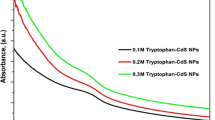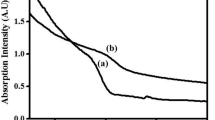Abstract
Cadmium sulfide nanoparticles (CdS NPs) were successfully prepared using sonochemical method by employing Schiff-base, (2-[(4-methoxy-phenylimino)-methyl]-4-nitro phenol) as a complexing agent. Here, SB is used as a ligand to control the morphology of NPs. XRD patterns and TEM images show that the synthesized CdS NPs have cubic structures with a diameter of about 2–10 nm. The formation of CdS NPs and their optical, structure, thermal and morphologies were studied by means of UV-vis DRS, fluorescence, FTIR, zeta potential, XRD, SEM and TEM. The interactions between CdS NPs and SB were investigated in an aqueous solution using fluorescence spectroscopy. The fluorescence quenching studies suggest that SB quenches the fluorescence of CdS NPs effectively. The degradation kinetics of methyl red (MR) by the photocatalyst was followed by Langmuir-Hinshelwood model. The results revealed that photocatalytic degradation of MR by SB capped CdS NPs could be considered as a practical and reliable technique for the removal of environmental pollutants. The antibacterial activity of samples was evaluated against E. coli, S. aureus and P. aeruginosa and the results were compared. SB and SB capped CdS NPs could be a potential antibacterial compounds after further investigation.
















Similar content being viewed by others
References
Alivisatos AP (1996) Semiconductor clusters, nanocrystals, and quantum dots. Science 271:933–937. doi:10.1126/science.271.5251.933
Yu WW, Peng X (2002) Formation of high-quality CdS and other II-VI semiconductor nanocrystals in noncoordinating solvents: tunable reactivity of monomers. Angew Chem Int Ed 41:2368–2371
Jie JS, Zhang WJ, Jiang Y, Meng XM, Li YQ, Lee ST (2006) Photoconductive characteristics of single-crystal CdS nanoribbons. Nano Lett 6:1887–1892. doi:10.1021/nl060867g
Qingqing W, Gang X, Gaorong H (2005) Solvothermal synthesis and characterization of uniform CdS nanowires in high yield. J Solid State Chem 178:2680–2685. doi:10.1016/j.jssc.2005.06.005
Ma X, Xu F, Liu Y, Liu X, Zhang Z, Qian Y (2005) Double-dentate solvent-directed growth of multi-armed CdS nanorod-based semiconductors. Mater Res Bull 40:2180–2188. doi:10.1016/j.materresbull.2005.07.009
Wang Y, To CY, Ng DHL (2006) Controlled synthesis of CdS nanobelts and the study of their cathodoluminescence. Mater Lett 60:1151–1155. doi:10.1016/j.matlet.2005.10.098
Murugan AV, Sonawane RS, Kale BB, Apte SK, Kulkarni AV (2001) Microwave–solvothermal synthesis of nanocrystalline cadmium sulfide. Mater Chem Phys 71:98–102
Kristl M, Ban I, Danc A, Danc V, Drofenik M (2010) A sonochemical method for the preparation of cadmium sulfide and cadmium selenide nanoparticles in aqueous solutions. Ultrason Sonochem 17:916–922. doi:10.1016/j.ultsonch.2009.12.013
Bao C, Jin M, Lu R, Xue P, Zhang Q, Wang D, Zhao Y (2003) Surfactant–ligand co-assisted solvothermal technique for the synthesis of different-shaped CdS nanorod-based materials. J Solid State Chem 175:322–327. doi:10.1016/S0022-4596(03)00298-6
Pol VG, Palchik O, Gedanken A, Felner I (2002) Synthesis of europium oxide nanorods by ultrasound irradiation. J Phys Chem B 106:9737–9743. doi:10.1021/jp025864g
Gates B, Mayers B, Grossman A, Xia Y (2002) A sonochemical approach to the synthesis of crystalline selenium nanowires in solutions and on solid supports. Adv Mater 14:1749–1752
Katoh R, Tasaka Y, Sekreta E, Yumura M, Ikazaki F, Kakudate Y, Fujiwara S (1999) Sonochemical production of a carbon nanotube. Ultrason Sonochem 6:185–187
Wang H, Lu YN, Zhu JJ, Chen HY (2003) Sonochemical fabrication and characterization of stibnite nanorods. Inorg Chem 42:6404–6411. doi:10.1021/ic0342604
Niasari MS, Hosseinzadeh G, Davar F (2011) Synthesis of lanthanum carbonate nanoparticles via sonochemical method for preparation of lanthanum hydroxide and lanthanum oxide nanoparticles. J Alloys Compd 509:134–140. doi:10.1016/j.jallcom.2010.09.006
Buitron G, Quezada M, Moreno G (2004) Aerobic degradation of the azo dye acid red 151 in a sequencing batch bio-filter. Bioresour Technol 92:143–149. doi:10.1016/j.biortech.2003.09.001
Sokmen M, Allen DW, Akkas F, Kartal N, Acar F (2001) Photodegradation of some dyes using Ag-loaded titanium dioxide. Water Air Soil Pollut 132:153–163
Sauer T, Neto GC, Jose HJ, Moreira RFPM (2002) Kinetics of photocatalytic degradation of reactive dyes in a TiO2 slurry reactor. J Photochem Photobiol A Chem 149:147–154
Rajeshwar K, Osugi ME, Chanmanee W, Chenthamarakshan CR, Zanoni MVB, Kajitvichyanukul P, Ayer RK (2008) Heterogeneous photocatalytic treatment of organic dyes in air and aqueous media. J Photochem Photobiol C 9:171–192. doi:10.1016/j.jphotochemrev.2008.09.001
Lachheb H, Puzenat E, Houas A, Ksibi M, Elaloui E, Guillard C, Herrmann JM (2002) Photocatalytic degradation of various types of dyes (Alizarin S, Crocein Orange G, Methyl Red, Congo Red, Methylene Blue) in water by UV-irradiated titania. Appl Catal B Environ 39:75–90. doi:10.1016/S0926-3373(02)00078-4
Guindo MC, Zurita L, Duran JDG, Delgado AV (1996) Electrokinetic behavior of spherical colloidal particles of cadmium sulfide. Mater Chem Phys 44:51–58
Matijevic E, Wilhelmy DM (1982) Preparation and properties of monodispersed spherical colloidal particles of cadmium sulfide. J Colloid Interface Sci 86:476–484. doi:10.1016/0021-9797(82)90093-5
Alivisatos AP (1996) Perspectives on the physical chemistry of semiconductor nanocrystals. J Phys Chem 100:13226–13239
Burda C, Chen X, Narayanan R, El-Sayed MA (2005) Chemistry and properties of nanocrystals of different shapes. Chem Rev 105:1025–1102. doi:10.1021/cr030063a
Smith AM, Nie S (2004) Chemical analysis and cellular imaging with quantum dots. Analyst 129:672–677
Sharma P, Brown S, Walter G, Santra S, Moudgil B (2006) Nanoparticles for bioimaging. Adv Colloid Interface Sci 123:471–485. doi:10.1016/j.cis.2006.05.026
Wu CL, Zhao YB (2007) CdS quantum dots as fluorescence probes for the sensitive and selective detection of highly reactive HSe − ions in aqueous solution. Anal Bioanal Chem 388:717–722. doi:10.1007/s00216-007-1246-7
Chen JL, Zhu CQ (2005) Functionalized cadmium sulfide quantum dots as fluorescence probe for silver ion determination. Anal Chim Acta 546:147–153. doi:10.1016/j.aca.2005.05.006
Gaballa AS, Asker MS, Barakat AS, Teleb SM (2007) Synthesis, characterization and biological activity of some platinum (II) complexes with Schiff bases derived from salicylaldehyde, 2-furaldehyde and phenylenediamine. Specrochim Acta A 67:114–121. doi:10.1016/j.saa.2006.06.031
Shi L, Ge HM, Tan SH, Li HQ, Song YC, Zhu HL, Tan RX (2007) Synthesis and antimicrobial activities of Schiff bases derived from 5-chloro-salicylaldehyde. Eur J Med Chem 42:558–564. doi:10.1016/j.ejmech.2006.11.010
Isin K, Erbil A, Ferda E, Samil I (2009) 2-[(4-Methoxyphenyl)iminomethyl]-4-nitrophenol. Acta Crystallogr E 65:0737. doi:10.1107/S1600536809008150
Hu Y, Liu Y, Qian H, Li Z, Chen J (2010) Coating colloidal carbon spheres with CdS Nanoparticles: microwave-assisted synthesis and enhanced photocatalytic activity. Langmuir 26:18570–18575. doi:10.1021/la103191y
Liu B, Lee JY (2005) Ordered alignment of CdS nanocrystals on MWCNTs without surface modification. J Phys Chem B 109:23783–23786. doi:10.1021/jp056196c
Sahu M, Biswas P (2011) Single-step processing of copper-doped titania nanomaterials in a flame aerosol reactor. Nanoscale Res Lett 6:441–455
Koneswaran M, Narayanaswamy R (2009) Mercaptoacetic acid capped CdS quantum dots as fluorescence single shot probe for mercury (II). Sensors Actuators B 139:91–96. doi:10.1016/j.snb.2008.09.011
Valeur B (2002) Molecular fluorescence: principles and applications, 1st edn. Wiley-VCH Verlag GmbH, Wenham
Navio JA, Testa JJ, Djedjeian P, Padron JR, Rodriguez D, Litter MI (1999) Iron-doped titania powders prepared by a sol–gel method.: part II: photocatalytic properties. Appl Catal Gen 178:191–203. doi:10.1016/S0926-860X(98)00286-5
Hoffmann MR, Martin ST, Choi W, Bahnemann DW (1995) Environmental applications of semiconductor photocatalysis. Chem Rev 95:69–96
Preis S, Krichevskaya M, Terentyeva J (1999) Treatment of phenolic and aromatic amino compounds by photocatalytical oxidation in polluted waters. TiO2-4: The Fourth International Conference on TiO2 Photocatalytic Purification and Treatment of Water and Air, Albuquerque
Martin S, Herrmann H, Choi W, Hoffmann ZM (1995) Photochemical destruction of chemical contaminants on quantum sized semiconductor particles. Solar Eng ASME 1:409–413
Lepore GP, Langford CH, Vichova J, Vlcek A (1993) Photochemistry and picosecond absorption spectra of aqueous suspensions of a polycrystalline titanium dioxide optically transparent in the visible spectrum. J Photochem Photobio A Chem 75:67–75. doi:10.1016/1010-6030(93)80161-2
Zhang Z, Wang C, Zakaria R, Ying JY (1998) Role of particle size in nanocrystalline TiO2-based photocatalysts. J Phys Chem B 102:10871–10878
Sanchez-Prado L, Llompart M, Lores M, Garcia-Jares C, Bayona JM, Cela R (2006) Monitoring the photochemical degradation of triclosan in waste water by UV light and sunlight using solid-phase microextraction. Chemosphere 65:1338–1347. doi:10.1016/j.chemosphere.2006.04.025
Houas A, Lachheb H, Ksibi M, Elaloui E, Guillard C, Herrmann JM (2001) Photocatalytic degradation pathway of methylene blue in water. Appl Catal B Environ 31:145–157
Osowole AA, Kolawole GA, Fagade OE (2008) Synthesis, characterization and biological studies on unsymmetrical Schiff-base complexes of nickel(II), copper(II) and zinc(II) and adducts with 2,2′-dipyridine and 1,10-phenanthroline. J Coord Chem 61:1046–1055. doi:10.1080/00958970701482446
Acknowledgments
The authors would like to acknowledge Head, Department of Chemistry, Osmania University for providing necessary facilities. One of the authors, D. Ayodhya wishes to thank the UGC, New Delhi for award of SRF which supported this work.
Author information
Authors and Affiliations
Corresponding author
Rights and permissions
About this article
Cite this article
Ayodhya, D., Venkatesham, M., Kumari, A.S. et al. Synthesis, Characterization, Fluorescence, Photocatalytic and Antibacterial Activity of CdS Nanoparticles Using Schiff Base. J Fluoresc 25, 1481–1492 (2015). https://doi.org/10.1007/s10895-015-1639-5
Received:
Accepted:
Published:
Issue Date:
DOI: https://doi.org/10.1007/s10895-015-1639-5




